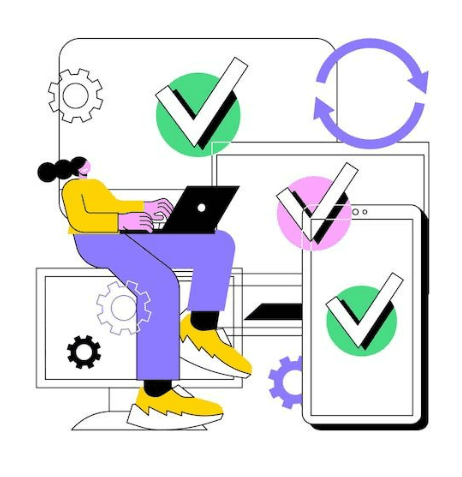Compatibility testing techniques, best practices, and why it's crucial for seamless software performance across various platforms and devices. The post Guide For Compatibility Testing: Techniques and Best Practices appeared first on ACCELQ Inc.
Guide For Compatibility Testing: Techniques and Best Practices

From addressing the needs of a diverse user base to nurturing user satisfaction and loyalty, it's critical for applications today to perform consistently across various hardware and operating system configurations. Otherwise, enterprises are inviting high customer churn, reputational damage, and limited market reach. They’re also looking at diminished competitive edge and even compliance risks (such as not adhering to the accessibility standards).
Research reveals that 88% of users abandon an app if it doesn’t perform well. However, ensuring software compatibility is no piece of cake. Platform and OS configurations, user expectations, localization issues, interoperability capabilities, and more — there's often a lot for product teams to account for.
Therefore, in this guide, we walk you through the nitty-gritty of compatibility testing and the best practices to get it right.
What Is Compatibility Testing?
Compatibility testing, a software testing type, aims to verify whether a software product functions correctly in its intended environment. Simply put, it's concerned with checking the functionality of an application on different browsers, devices, platforms, and operating systems. There are more avenues to it, of course, when we take into account compatibility across networks, databases, versions, and even performance under varying conditions.
For the sake of an overarching definition, though, the primary goal of compatibility testing is to ensure that the application runs seamlessly in different environments.
It's important to note that compatibility testing falls under non-functional testing. Ideally, it is taken up when the build becomes stable.
Download the 100% Free Guide
Master the essentials of advanced approach
to object recognition.

Techniques for Compatibility Testing
Compatibility testing is broadly divided into two: forward compatibility and backward compatibility. These further include categories like browser testing, hardware testing, network testing, version testing, OS testing, etc.
Forward Compatibility Testing
Forward compatibility testing is a way to check if the application under test is compatible with future or new versions of software or hardware.
Backward Compatibility Testing
Backward (or downward) compatibility testing assesses if the application being tested works well with previous versions of software or hardware. So, by definition, backward testing works well to ensure that people using older devices or platforms to run the applications experience seamless performance.
Why Do Compatibility Testing?

Why exactly do we need to conduct compatibility testing? And why is it an essential part of QA and software development? Let's discuss.
Seamlessly Functioning Across Diverse Operating Systems and Devices
Compatibility testing is critical to affirming that your application operates seamlessly on various operating systems and devices. What does this help confirm? For one, compatibility ensures a consistent, bug-free, and user-friendly customer experience. Also, it's essential in the context of globalizing software solutions and ensuring that they'll support seamless cross-platform functioning.
Early Identification and Resolution of Compatibility Issues
We've often heard how identifying and resolving issues in the post-launch phase can prove exceptionally costly, and understandably so. Compatibility testing wards off this challenge by helping with the early detection and prompt resolution of compatibility issues.
A Key to a Successful Product Launch
A successful product launch is often contingent on the application's compatibility with various environments. Compatibility testing helps you avoid potential disasters on launch day by ensuring your product is ready to perform optimally on different platforms, resulting in higher customer satisfaction and positive reviews.
Is Compatibility Testing the Same as Cross-Browser Testing?
From the looks of it, cross-browser and compatibility testing appear the same. In truth, there are subtle differences worth considering. Here's a rundown of the same:
Essentially, all cross-browser tests are compatibility tests. However, not all compatibility tests are cross-browser tests.
Best Practices for Compatibility Testing

Compatibility testing proves immensely viable because it helps enterprises meet user expectations. But getting it right might prove an arduous task. To address this challenge, developers must follow these best practices:
Narrow Down on the Target Platforms and Requirements
Identify the platforms, devices, and browsers you need to test your software on. This identification process will heavily rest on the target audience and the intended use of the software. Imagine a scenario where you are developing a mobile app. You would need to test it on various devices, such as smartphones, tablets, etc.You will also have to evaluate it on different operating systems like iOS, Android, and Windows.
Prioritize Compatibility Tests
It's safe to say that not all compatibility tests are created equal. Scope and depth of testing, techniques employed, time constraints, the experience of the testing team, stakeholder requirements, and testing objectives — there are a host of things that weave in differentiation among tests.
Hence, the situation transpires where some tests become more important than others. This means that it's critical to prioritize your testing efforts. What does this entail? Simply put, focus on testing the most critical features and functionality, as well as any features known to be problematic. So, let's say that your software has a component used by most of your users. In that case, this component qualifies as a good candidate for prioritized testing.
Notably, you can also prioritize your testing based on the risk of a compatibility issue. For instance, if your software is being leveraged in a mission-critical environment, you will want to prioritize testing for those scenarios.
Test Early and Often
The early testing principles apply well to compatibility testing efforts. It makes sense to identify and fix compatibility issues as early as possible to curtail time and money investments. The good thing is that developers can leverage emulators and simulators to test their software on various platforms and devices. They should start testing on real devices as they get closer to release.
It's also important to test your software frequently throughout the development process. This will help you catch any compatibility issues that transpire as the software evolves.
Test in Real-World Scenarios
Testing in real-world scenarios, which might encompass varying network conditions, versions, devices, etc., is critical. It is, in fact, imperative to see how the software performs outside a controlled environment. You can also get feedback from real users to unearth any compatibility issues they are experiencing.
Retest the Software
Even after you have completed compatibility testing, it's important to retest your software regularly. Why? Because the software landscape constantly evolves, new compatibility issues can arise over time. It would be best if you also retested your software after making any changes to it, such as carrying out bug fixes or adding new features.
Conclusion
Compatibility testing is integral to software development endeavors It lends confirmation that the application works as intended on the targeted platforms, devices, and browsers. The above outlined best practices hold the key to ensuring that your software is compatible with different environments and delivers a seamless, bug-free user experience.
To ensure that compatibility testing efforts are consistent, scalable, efficient, and accurate, automating them proves viable. This is precisely where a robust, codeless test automation tool like ACCELQ becomes a key enabler of faster, improved, and more accurate compatibility testing. Contact us to learn more about how ACCELQ can help.
Suma Ganji
Senior Content Writer
Expertly navigating technical and UX writing, she crafts captivating content that hits the mark every time. With a keen SEO understanding, her work consistently resonates with readers while securing prime online visibility. When the day's work ends, you'll find her immersed in literary escapades in her quaint book house.
Discover More
The post Guide For Compatibility Testing: Techniques and Best Practices appeared first on ACCELQ Inc.




















